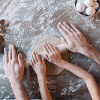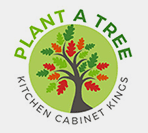How To Create A Childproof Kitchen To Keep Your Little Ones Safe
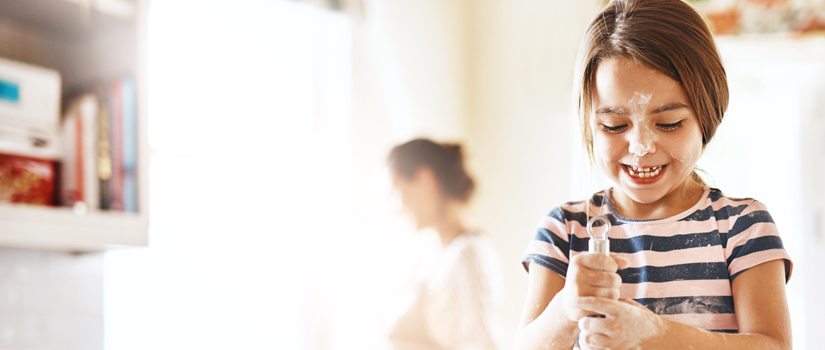
A kitchen is a place to get creative, gather, and enjoy delicious meals. For many families, it's the (literal) hotspot of the home but when you have little ones crawling or running around, your kitchen can quickly turn into a danger zone. Childproofing your kitchen goes way past covering up electrical outlets and keeping sharp knives out of reach for little fingers.
To help you childproof (also called baby proof) your kitchen for the whole family, we've put together the ultimate guide to creating a safe kitchen. Whether you'll be adding extra safety measures to protect your curious toddler from pinching their fingers between cabinet doors or to keep your fur baby from exploring the inside of your refrigerator, with the help of our guide your mind will soon be at ease.
What To Know Before Getting Started Baby Proofing
Try to put yourself in the shoes of your toddler. Anything that's behind closed doors or above their eye level is a mysterious place that needs to be discovered. This means that there are a few general things to consider when baby proofing your kitchen:
- Children should never spend time in the kitchen unsupervised.
- Make sure to store trash cans behind closed doors or install a pull-out drawer to keep your child from digging through it.
- Plastic bags should always be stored in a hard to reach place to prevent your toddler or child from pulling them over their head and suffocating.
- Outlets should be secured with plastic covers.
- Turn appliances off as soon as you're done using them so your child doesn't risk getting burnt.
- When you're handling sharp knives or other dangerous objects, try to keep your child out of reach in a safe zone.
If you don't trust yourself with baby proofing your home, you can always hire a professional!
Childproof Your Kitchen Step-by-Step


Consider each zone of the kitchen and dining area to create a safe space for your kids. Follow the steps below to make sure every corner of your kitchen is a safe place for your curious toddler or fur child.
Step 1: Baby Proof Oven + Other Appliances

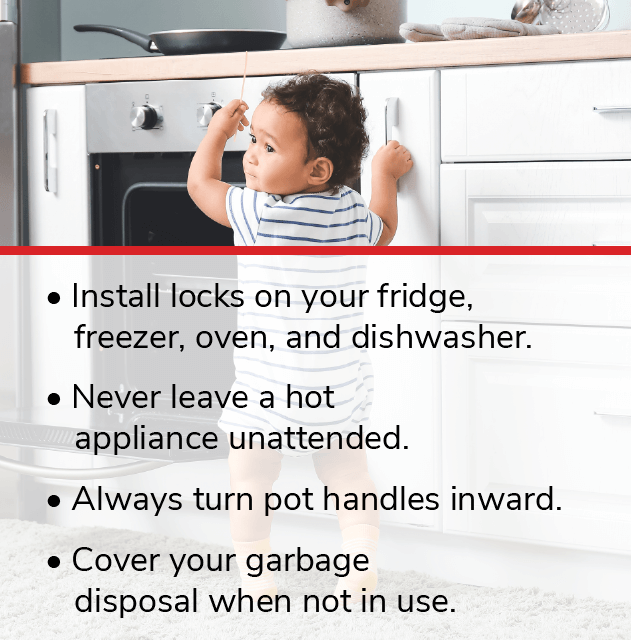
Next to easily accessible sharp knives and toxic cleaning solutions, appliances are the most dangerous part of your kitchen. They reach dangerous temperatures, are connected to electricity, and can spin out of control when handled without care. Here are some tips on how to childproof your kitchen appliances.
Refrigerator and Freezer
Installing locks or latches at a height they can't reach will protect your child from climbing into your fridge or freezer and potentially suffocating.
Once your child is older and you trust them with getting their own snacks out of the fridge (or a popsicle out of the freezer on a hot summer day), it's all about organization. Keep messy items (like sauces and juices) on higher shelves, that your child can't reach yet. You can also install drawers or other inserts specifically for child-friendly snacks at the bottom of the refrigerator to clearly indicate which zones of the fridge are okay for your child to access and which aren't.
Oven and Stove
Cooking with your kids can be a true joy. Whether you're baking cookies together for a bake sale or cooking mashed potatoes for dinner, involving your children in these tasks early on gives them a better understanding of the value that food holds and offers you an opportunity to teach them about the risks a kitchen can bear. According to the CDC, over 300 children are treated in U.S. emergency rooms for burn-related injuries every day. For younger children, these often occur in the kitchen.
To prevent your child from getting injured, you should never leave the stove unattended. Make sure your child understands that the stovetop will be hot for a while after turning it off and removing pots or pans from the heat. If it's available to you, you may consider an induction cooktop. They only heat up the pan and pot and will cool down within seconds after use which makes them a safer cooktop to have around children and pets.
Always keep pot handles turned inward so a child running by the stove can't accidentally knock off a pot full of boiling water. For children that are beyond curious and won't listen until they've experienced the pain of burning themselves, you can install a stove guard. This plastic or metal enclosure allows you to move around the kitchen freely without worrying about your toddler accessing your hot cooktop.
To keep your child from burning themselves on an oven rack, pinching their fingers between the oven doors, or even hitting their head after pulling too hard on the oven door, you can install an oven lock. For oven and stove knobs that are located within toddler-reach, you can attach stove knob covers that prevent the knobs from turning.
Dishwasher
Besides installing a lock on the dishwasher door, it's important to never leave it open and unattended while children are around. You can risk them unloading it and creating a huge mess but also don't want your kids to injure themselves on knives or other sharp objects. Just in case your kid does get their hands into the dishwasher, avoid adding detergent until you run it. Detergents are toxic and can poison children who eat it.
Small Appliances
Any appliance that plugs into an outlet is a potential hazard when you have children at home. It's best to unplug your toaster, blender, coffee maker, or food processor after you're done using it. If you have enough space in your kitchen, store these appliances away. Otherwise, ensure that the cords are tucked away so your child can't pull on them (you can also use cord shorteners or outlet covers).
A microwave is best kept behind closed cabinet doors or pushed against a wall if it's not installed at a height that's beyond your child's reach.
Your garbage disposal is one of the most serious risk factors in your kitchen. If you're renting, make sure to cover the drain and childproof the garbage disposal light switch with a cover. In a purchased home, you can install a batch feed system that prevents the garbage disposal from operating unless it is covered.
Step 2: Baby Proofing Kitchen Cabinets and Drawers

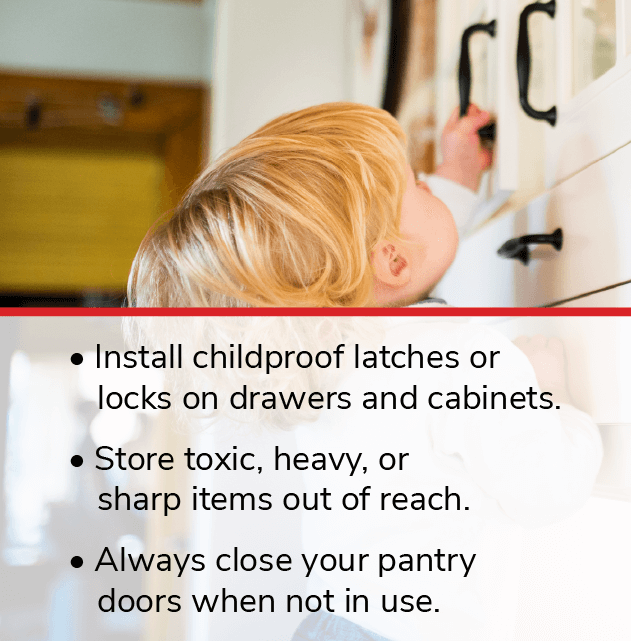
“It's remarkable how easy it is to open cabinets, to climb up on furniture, to get into [...] things that you wouldn't necessarily think they'd be interested in,” Dr. Scot Bateman, M.D., professor of pediatrics at the University of Massachusetts Medical School points out. “As soon as they're mobile, children are very curious.”
So remember: There is one very simple way to keep your kids out of your cabinets and drawers: install childproof locks or latches. If your children like to hang out in the kitchen while you're working in it, there are a few more precautions you can take to protect them should they find a way to get past the locks.
Lower Cabinets
Lower cabinets are what toddler dreams are made of. Your curious kid wants to explore it all, especially what's behind closed doors. If you're worried about leaving the doors open while your child is in the kitchen, it's best to only store items in lower cabinets that are harmless and can't break. In the worst-case scenario, your child will make a mess with plastic bowls, pots, or pans but at least they won't get hurt.
Store anything that's toxic, made of glass, has sharp edges, or is particularly heavy (like your grandmother's dutch oven) out of reach.
Drawers
While your toddler may be too small to reach into kitchen drawers, smaller children can find some seriously dangerous items in them: graters, knives, and scissors are no toys. So make sure to baby proof drawers by installing proper child locks. By inviting your kid into the kitchen and showing them how some utensils work (e.g. grate cheese with them) you can sharpen their awareness of the dangers these items present.
Pantry
It goes without saying that an open pantry is not ideal when you have unruly pets or adventurous kids around. Your child may find it inviting to climb up the shelves, pull, or push items off. Your pantry doors should always be closed when you're not accessing it, have a child lock installed, and alway so stick to rule number one: Store dangerous items up top!
Step 3: Childproof Your Countertops and Dining Area
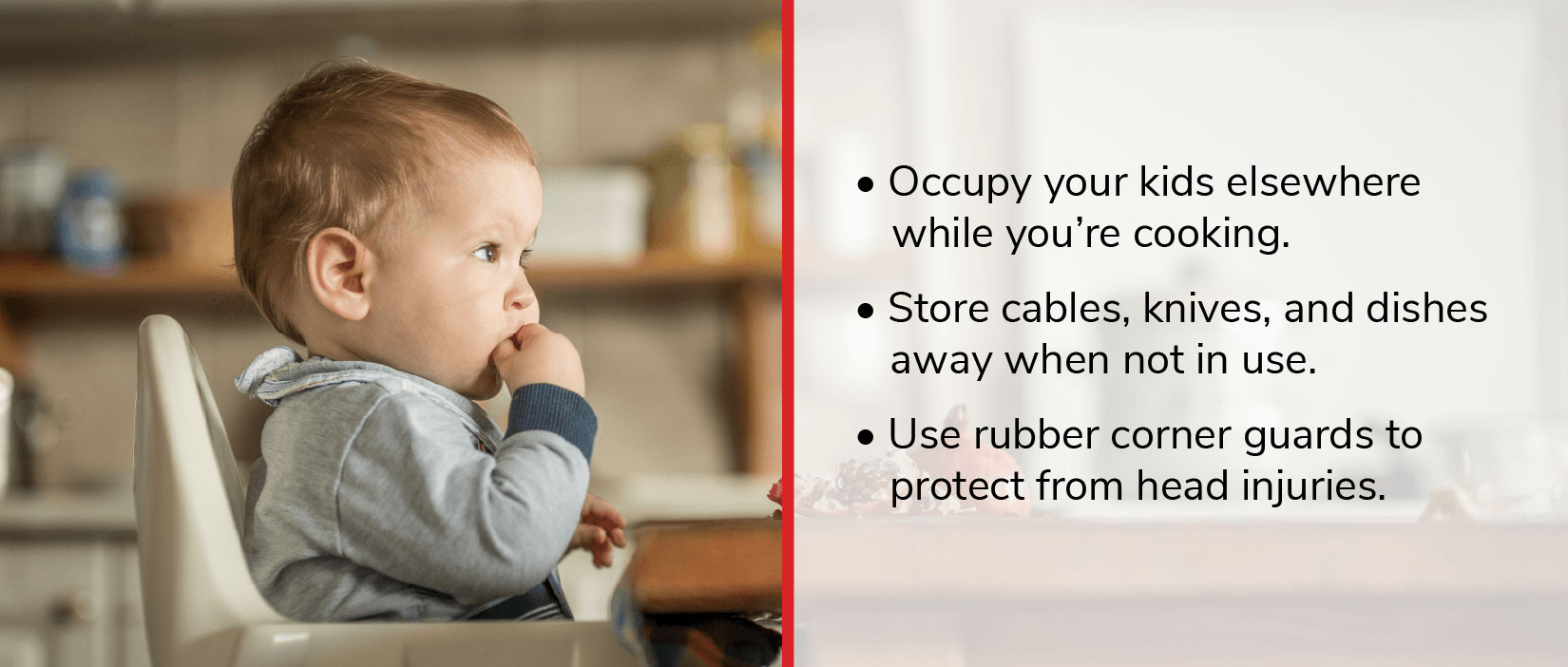
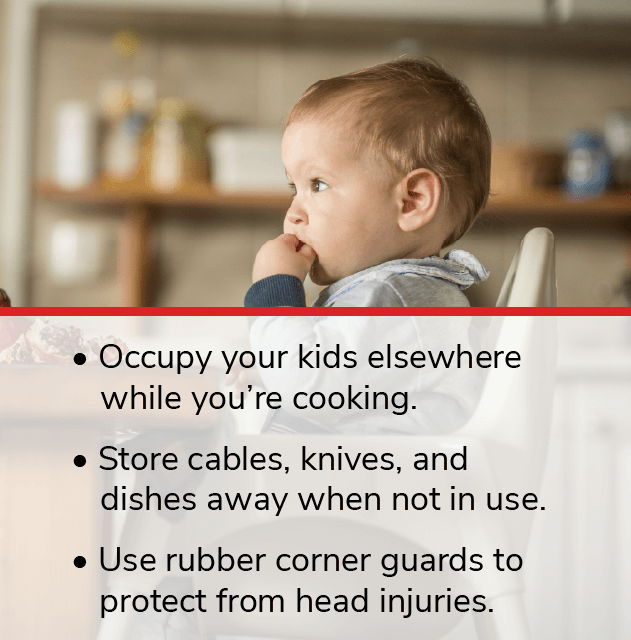
Last but not least, you should childproof kitchen and dining room surfaces. Here are our final tips to make your kitchen and dining area a hazard-free zone for your kids.
Countertops
While you're working in the kitchen, things can get messy. It's best to keep your kids occupied in a different space while you're preparing food. If you have an open concept kitchen, your child can play in the living area where you can still keep an eye on them. If they're on the younger side and your kitchen doesn't overlook the living area of your home, keep your child occupied in a highchair or a playpen within sight.
When the kitchen is not in use, you can minimize the risk of injury by tucking away cables of small appliances like your toaster oven and storing kitchen machines such as your food processors in a locked cabinet. Knife blocks can be a hazard to kids trying to reach up on the countertop so the most child-safe knife storage is behind closed doors or in a drawer with a child lock.
Dining area
The dining area presents different risks to your child. A rectangular table can have sharp edges that your child can run into. You can add corner guards made of rubber to your dining table or countertop to prevent painful head injuries. A round table on a pedestal can easily be tipped over so ensure that it's anchored to the floor. Don't allow your children to climb on tables and chairs to prevent them from falling off and always shove chairs flush against the table when they're not in use.
If your furniture is made of wood, check for nails and splinters that could injure your child. Fine china and glassware are best stored behind closed, secured doors. A tablecloth is a beautiful piece of decor but also an invitation for your child to pull on it. Instead of a cloth, use a pretty placemat to decorate your dining table.
If you don't have a dining table but gather at your kitchen counter for meals, apply the same precautions to create a safe environment for your child.
How to Childproof Your Kitchen FAQs
Parenting is hard but baby-proofing your kitchen doesn't have to be. If you have any unanswered questions at this point, read our FAQs below to find answers.
How do I childproof my kitchen?
To childproof your kitchen, you'll need latches or locks to secure drawers, cabinets, and appliances. It's best to store toxic or dangerous items like detergents or knives in hard to reach places so toddlers and young kids don't have access. Unplug small appliances when they're not in use and make sure to tuck the cables away so your children can't pull on them. Try to keep your kitchen out of the kitchen when you're cooking or baking so they're not at risk to burn themselves.
How do you baby proof a stovetop?
You can make a stovetop childproof by using the backburner instead of the front of the stove. Always turn pot and pan handles inward so children that are running by don't accidentally hit them and spill hot fluids on themselves. You can also install a stove guard and remove stove knobs so your kids can't turn the stove on by themselves.
How do I keep my kids out of the cabinets?
You can keep your curious kids out of kitchen cabinets by installing childproof latches or locks. Make sure to install them at a height your child can't access.
How do I childproof cabinets without handles?
You can install childproof latches on cabinets with or without handles. To baby-proof a cabinet without handles, we suggest using magnetic locks that are hard mounted on the inside of the cabinet or latch locks that drill into the cabinet door to secure it from the outside.
Childproofing your kitchen is essential when you have a toddler or curious kid at home. We hope our guide helps you to protect your family from harm, your sanity as a parent, and your kitchen cabinets from turning into a giant mess.





 min
min
